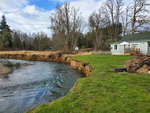
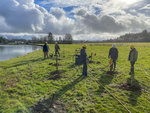
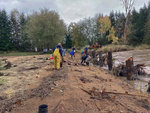
.jpg)
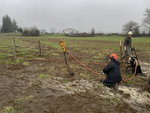
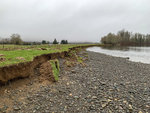
A pilot project to stave off erosion on the banks of rivers in the Chehalis Basin is showing initial signs of success.
The work was part of a $1.6 million investment by the Office of the Chehalis Basin to manage erosion by purchasing property, developing a streamflow gauge plan and testing how ground and surface waters mix with a demonstration project along the banks of the Satsop River just outside of Brady, according to a newsletter from the Office of the Chehalis Basin.
Beyond just its impacts on fish and flooding, erosion on the Satsop and Chehalis in the Montesano area has reduced farmlands and destroyed houses. Erosion has been a longstanding problem in the basin, progressing for decades sometimes more than 100 feet per year. Since 1991, one landowner in the pilot project area has lost approximately 30 acres of banksideland.
After property was purchased, the Chehalis Basin Strategy spent $14,600 on the pilot project to create an “instant” river bank erosion buffer by planting 350 six to 10 foot tall native cottonwood and willow live poles in February 2022.
Crews from Grays Harbor Conservation District and the Washington Conservation Corps installed the poles on the banks of the Satsop River. Erected like fence posts, the pole bases were buried anywhere between 3 to 8 feet deep.
“We used these techniques so that we could get them as deep as possible, to hopefully get roots establishing throughout the potential erosion zone,” said Anthony Waldrop, Grays Harbor Conservation District director. “Depth also makes the live poles more resilient to summer drought conditions, as their roots can access deeper groundwater.”
As of September 2022, about 80% of the trees had survived.
“All of the poles did well initially during the wet spring, but as the soil dried out, those that were only driven three feet into the ground had trouble surviving during the summer drought. Poles that were deeper, however, were able to thrive with access to water all summer long,” Waldrop said.
Some of the trees had even grown upwards of 10 feet and were not having trouble competing with non-native weeds such as reed canary grass, according to the newsletter. Maintenance and monitoring of this pilot project will continue this spring.
The project pairs with the Chehalis Basin Strategy’s Aquatic Species Restoration Plan by planting river bank vegetation in addition to the installation of log jams to increase habitat complexity, connect floodplains and slow erosion.
That Aquatic Species Restoration Plan work has been done by landowners and the Grays Harbor Conservation District since 2020. Due to the project’s scale and complexity, further construction can be expected in the summers of 2023 and 2024.
The Aquatic Species Restoration Plan project is aimed to benefit four species of salmon but will reportedly also have benefits for waterfowl, amphibians and other native fish, according to the office.
Additionally, another erosion reduction pilot project has been started along state Route 508 with properties near the South Fork of the Newaukum River, headed by the Office of the Chehalis Basin and Lewis County Conservation District. This project is also known as the MacBryer project.
Of seven properties in the area, three are in imminent danger according to Lewis County Conservation District Director Bob Amrine.
“One site had encroachment on the septic system, one site was where the river was right next to state Highway 508, and the other site was the MacBryer site, where the house was determined to be in imminent danger,” said Amrine.
Amrine added the South Fork moved 15 to 20 feet in the last year alone and has moved over 100 feet in recent years.
“The bank started disappearing, we’ve lost over 40 feet in six years,” Homeowner David MacBryer said.
The site was assessed in March 2022, then construction began in September and involved the creation of log “cribwall jams,” regrading upper parts of the river bank, installing erosion-control fabric, live willow and preparing the site for more vegetation.
Members of the Lewis County Stream Team, a branch of the district which includes volunteers, worked to plant 25 potted willow trees, 25 red osier dogwood trees, 10 western red cedar trees, 10 Douglas fir trees and 100 willow stakes in November.
Now completed, the project is in the monitoring stage. In total, it cost $168,000.
“We are watching it close during high-water events, and the log cribwall seems to be functioning as designed,” Amrine said. “We have a 10-year agreement with Mr. MacBryer, and if he sees anything that looks like the project is in danger, he will call us, and we will attempt to assist at that time. Hopefully, this does not happen.”
According to MacBryer, most of the trees are doing well, but the cedars are struggling.
For more information, visit https://ecology.wa.gov/Blog/Posts/January-2023/Pilot-projects-designed-to-curb-bank-erosion-showi.